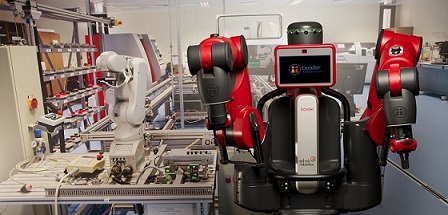We generally associate industrial robotics with the kind of robotic arms used on production lines in the automotive industry. This is a common image. These robots, derived from automatism, are efficient, accurate and rapid. Since Unimate, the first industrial robot used by General Motors in 1961, these robots have made great progress and are continuing to do so. However, although we have become very good at automating tasks at the beginning of a production process, for manufacturing vehicles for example, we have a harder time automating those at the end of the line, which require more labour.
Recently, a new wave of industrial robots has emerged, lending insight into what the factory of the future might look like. This new generation of robot will be used to automate a wide variety of tasks that previously had to be done by hand. Often, and sometimes wrongly, gathered under the collective banner of collaborative robot, or Cobot , these robots have a number of points in common:

Cobots are designed to work in close collaboration with humans, and give us an indication of the kind of technologies that will be used by the robots of the future in our homes, and by other robots used for caring for dependents. Unlike traditional industrial robots, Cobots do not need to be isolated behind protective cages. They are safe because they can control their strength, either actively or passively, with no risk of injuring operators.
Another, and possibly the most important, advantage of these collaborative robots is that they can be easily taught new tasks. Unlike traditional industrial robots, which require the intervention of an expert, Cobots learn by copying demonstrated movements (the operator, quite literally, takes the robot by the hand to show it the task he wants it to perform) and using interfaces with icons and very little text, a bit like a smartphone. Operators with no computer programming or robotics skills are therefore able to program them. This simple but very powerful learning capacity combined with the robot’s ability to give a clear answer (in the form of behavioural feedback, like the Baxter robot’s eyes, which frown when it does not understand) make Cobots easy to use, hence opening up a multitude of possibilities.
Finally, these new technologies are very affordable, with several of the solutions on the market costing less than €50k. And most offer a return on investment in less than a year.

These three features make Cobots a much more flexible solution than the traditional industrial robots, although they are generally used as a complementary solution rather than as replacements. Cobotics is therefore of particular interest to micro-business and SMEs, which until now found it difficult to automate tasks, and for whom Cobots could well prove to be the ideal robotics solution for performing several different tasks in a single day.
Which of these new robots are currently or will soon be available? The following table presents a non-exhaustive overview of today’s collaborative robots.
| Robot | Manufacturer | Marketed? |
| Baxter | Rethink Robotics | Yes |
| UR5 et UR10 | Universal Robots | Yes |
| Autonomous Dual Arm Robot | Epson | No |
| NextAge | Kawada Industries | Yes |
| Frida | ABB | No |
| WorkerBot | PI4 Robotics | No |
| Justin | KuKA / DLR | No |
| Kuka LWR | Kuka | No |

